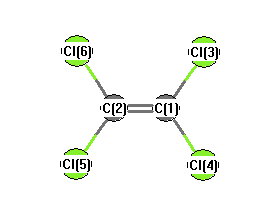Vibrational Frequencies calculated at HF/6-311G*
| Mode Number |
Symmetry |
Frequency
(cm-1) |
Scaled Frequency
(cm-1) |
IR Intensities
(km mol-1) |
Raman Act
(Å4/u) |
Dep P |
Dep U |
|---|
| 1 |
Ag |
1811 |
1638 |
0.00 |
|
|
|
| 2 |
Ag |
482 |
436 |
0.00 |
|
|
|
| 3 |
Ag |
264 |
239 |
0.00 |
|
|
|
| 4 |
Au |
109 |
99 |
0.00 |
|
|
|
| 5 |
B1u |
838 |
758 |
87.30 |
|
|
|
| 6 |
B1u |
344 |
312 |
0.38 |
|
|
|
| 7 |
B2g |
630 |
570 |
0.00 |
|
|
|
| 8 |
B2u |
985 |
891 |
189.76 |
|
|
|
| 9 |
B2u |
198 |
179 |
1.04 |
|
|
|
| 10 |
B3g |
1096 |
991 |
0.00 |
|
|
|
| 11 |
B3g |
376 |
340 |
0.00 |
|
|
|
| 12 |
B3u |
329 |
298 |
0.46 |
|
|
|
Unscaled Zero Point Vibrational Energy (zpe) 3730.9 cm
-1
Scaled (by 0.9044) Zero Point Vibrational Energy (zpe) 3374.2 cm
-1
See section
III.C.1 List or set vibrational scaling factors
to change the scale factors used here.
See section
III.C.2
Calculate a vibrational scaling factor for a given set of molecules
to determine the least squares best scaling factor.
Charges, Dipole, Quadrupole and Polarizability
Charges from optimized geometry at HF/6-311G*
Charges (e)
| Number |
Element |
Mulliken |
CHELPG |
AIM |
ESP |
| 1 |
C |
-0.076 |
0.100 |
|
0.050 |
| 2 |
C |
-0.076 |
0.100 |
|
0.050 |
| 3 |
Cl |
0.038 |
-0.050 |
|
-0.025 |
| 4 |
Cl |
0.038 |
-0.050 |
|
-0.025 |
| 5 |
Cl |
0.038 |
-0.050 |
|
-0.025 |
| 6 |
Cl |
0.038 |
-0.050 |
|
-0.025 |
Electric dipole moments
Electric dipole components in Debye
(What's a Debye? See section
VII.A.3)
| |
x |
y |
z |
Total |
| |
0.000 |
0.000 |
0.000 |
0.000 |
| CHELPG |
|
|
|
|
| AIM |
|
|
|
|
| ESP |
0.000 |
0.000 |
0.000 |
0.000 |
Electric Quadrupole moment
Quadrupole components in D Å
| Primitive |
|---|
| | x | y | z |
|---|
| x |
-63.017 |
0.000 |
0.000 |
| y |
0.000 |
-60.502 |
0.000 |
| z |
0.000 |
0.000 |
-62.416 |
|
| Traceless |
|---|
| | x | y | z |
|---|
| x |
-1.558 |
0.000 |
0.000 |
| y |
0.000 |
2.215 |
0.000 |
| z |
0.000 |
0.000 |
-0.656 |
|
| Polar |
|---|
| 3z2-r2 | -1.312 |
|---|
| x2-y2 | -2.515 |
|---|
| xy | 0.000 |
|---|
| xz | 0.000 |
|---|
| yz | 0.000 |
|---|
|
Polarizabilities
Components of the polarizability tensor.
Units are
Å
3 (Angstrom cubed)
Change units.
| |
x |
y |
z |
| x |
3.737 |
0.000 |
0.000 |
| y |
0.000 |
10.821 |
0.000 |
| z |
0.000 |
0.000 |
11.763 |
<r2> (average value of r
2) Å
2
| <r2> |
358.106 |
| (<r2>)1/2 |
18.924 |
